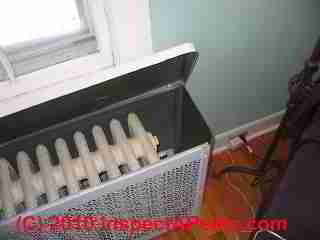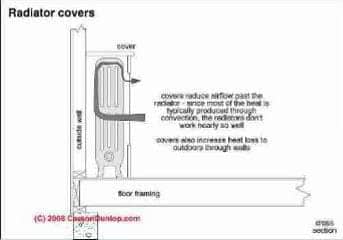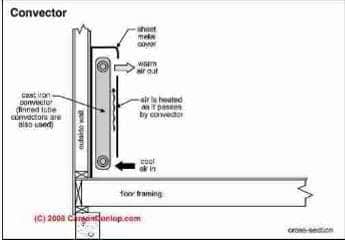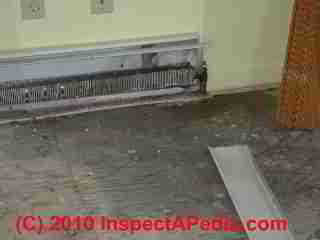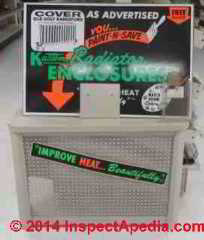 Heating Radiator & Baseboard Covers
Heating Radiator & Baseboard Covers
Impact on Heating Efficiency, Cost, & Energy Savings Suggestions
- POST a QUESTION or COMMENT about heating system radiator covers in buildings
Guide to radiator & baseboard or heating convector covers:
This article describes the types of heating radiators: hot water, steam, cast iron, heat convectors, baseboard heat, electric heating convectors, and we explain the diagnosis and repair of no-heat or leaks or other problems with heating radiators.
We explain the effects on heating output & distribution when a cover is placed around a conventional hot water or steam heating radiator, and we explain why covers are needed for proper functioning of hot water heating baseboards & convectors. We include sources of replacement baseboard covers & notes on where to buy or how to build a radiator cover.
How much does adding a radiator cover affect heating costs? Do hot water heating baseboards need their covers? Can I replace the original manufacturer's cover on my wall-mounted electric heating convector unit? What is the benefit of adding insulation or a heat reflector behind a radiator or convector unit?
Can I leave the covers off of my hot water heating baseboards? Where to get or how to build replacement covers for heating baseboards or radiators.
InspectAPedia tolerates no conflicts of interest. We have no relationship with advertisers, products, or services discussed at this website.
- Daniel Friedman, Publisher/Editor/Author - See WHO ARE WE?
Energy Saving Suggestions About Baseboard, Convector & Radiator Covers
Our photo at left above (at page top) shows a typical "one pipe system" steam cast-iron heating radiator behind a metal radiator cover. A single pipe delivers steam to the radiator and condensate from the cooling steam returns to the heating boiler via that same pipe.
Sketch at above right, provided courtesy Carson Dunlop Associates, shows the typical air inflow at the front of the radiator cover and outflow near the top as heated air rises by convection [Click to enlarge any image]. The CDA sketch points out that depending on its design, a radiator cover might actually reduce the heat output from the device!
Yet in some cases (such as baseboard radiators and convector units, the cover is absolutely necessary for proper operation. We will explain this if you can stand reading-onwards.
In addition to cast iron radiators using hot water or steam as a heat source, we describe two other very common hot water heat distribution methods below.
Effect of Different Radiator Cover Designs on Radiator Heat Output
How Much Do Radiator Covers Reduce Heat Output or Increase Heating Bills? Can Some Radiator Covers Increase Heat Output?
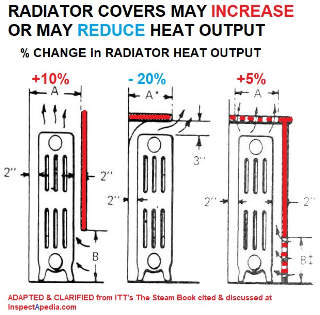
The two radiator cover sketches shown here are adapted from a now nearly-antique Steam Heat Book provided by ITT.[14]
We modified the illustration to show the actual affect on radiator heat outpout by covers of various designs.
In our two modified radiator cover design drawings, where the percentage we show above a radiator cover design is positive (+ and shown in RED ) that means that adding a radiator cover of that design actually increases the radiator's output.
Where the percentage we show above a radiator cover design is negative (- and shown in BLUE ) that means that adding a radiator cover of that design reduces the radiator's heat output.
You can see that in some designs the percentages of heat output from a radiator with one of these cover designs reduced (shown in blue) while in others the heat output is actually increased (shown in red), probably by improvements that increase the rate of air flow through the radiator and into the room.
While radiator covers are a popular way to modernize and improve the looks of steam or hot water radiators in a building, as Carson Dunlop Associates' sketch above left and the sketches we adapted from the ITT book all show, most but not all radiator covers will significantly reduce the heat output of the device.
Because adding a radiator cover in most of these designs slows the movement of heat out of the radiator and into the room, the rate of heat loss out through the building exterior wall is likely to be increased - also increasing your heating bills.
The original text's explanation was confusing to non-heating experts so here we have adapted and modified the original drawings provide a more-clear explanation of the percentages of change in radiator heat output due to different radiator cover designs derived from the original data. The original text did not cite a source for these percentages.
Originally the ITT authors translated the effect of radiator covers into the effect on total system heat output, and said that the designer would need to increase or decrease the total amount of heat radiating surfaces accordingly.
Below we show how to avoid this problem by adding solid insulation (usually foil-faced) behind the radiator and over the wall surface.
If the space between the radiator and the wall is too small to add much insulating board (less than1/2") or if adding insulation would totally block air flow in that area, you might prefer to install a foil reflector instead.
How to Make a Radiator Cover to Deliberately Reduce Heat Output
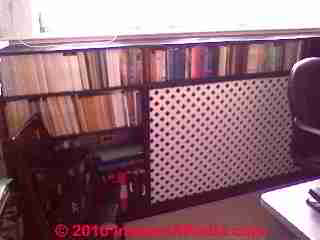
In field inspections we have not noticed a significant difference in the venting designs of covers over hot water radiators compared with electric convector units except in more extreme cases such as the radiator cover that we built for a Vassar College professor (left).
In the photo at left we show that we have enclosed the radiator on three sides and installed a louvered screen front. This was done deliberately to cut the heat output from this radiator.
Usually we like to use a very open screen material and have even used lattice with 1" openings so that we maximize airflow through the cosmetic screen of the cover (photo at left).
But in the example shown, a large cast iron radiator in an academic office was enclosed by shelving that we constructed deliberately to reduce heat output in a building where regulating heat among offices had proven difficult.
If the heat output is interfered-with on a hot water radiator, not much of a safety concern would be raised. But if we blocked heat output of an electric fan convector unit we might create an unsafe condition or even an electrical hazard or malfunction if internal components are overheated.
Adding Insulation or a Heat Reflector Behind Your Radiators
While you're at it, if your heaters are an older installation that was recessed into the building wall, you can greatly improve their heat output and perhaps significantly reduce heating costs if you move them forward to a flush-on-wall mount over a suitable insulating and/or heat reflecting board.
Carson Dunlop Associates' sketch (left) demonstrates the improvement in heat output (and thus reduced building heating bills) from simply adding insulation behind heating radiators.
Thanks to Bearsville NY Architect Barry Price for the tip about bringing recessed radiators forward Feb 2010.
Utica Boilers provides a useful document - Utica Radiation Tables - that allows a homeowner or heating service technician to determine the heat output of a traditional cast iron radiator, measured in square feet of radiation for column, tube, and wall-type heating radiators.
Radiator Covers Over Electric Heat Convectors and Fan Boosted Convection Heaters?
Wall-mounted electric heating convectors with or without a fan to increase air movement, are produced and designed to work with the cover provided by the manufacturer.
Some readers have asked if it was acceptable to replace the manufacturer's OEM cover with an alternative. Sketch (left) of a generic wall mounted heating convector and its heating convector cover is courtesy of Carson Dunlop Associates, a Toronto home inspection, education & report writing tool company [ carsondunlop.com ].
You may be risking a fire if you put any cover of any kind over or even close to a wall-mounted electric convector heater. Using the DeLonghi CH15 CH15F instruction manual as an example, that document describes a portable electric convection heater that includes a blower fan. The heater can also be wall-mounted. But the manufacturer specifically states,
"Keep combustible materials, such as furniture, pillows, bedding, papers, clothes, and curtains at least 3 feet (0,9 m) from the front and top of the heater and keep them away from the sides and rear."
Do not buy or make or install additional or retrofit or "cosmetic" covers for heaters of this type without first getting an OK from the manufacturer. You're risking a fire.
As we mention at the DeLonghi wall panel heater citation in Technical Reviewers & References below, we do not recommend modifying or covering any OEM wall-mounted panel heater covers without checking with the manufacturer as well as reviewing the heater's installation manual.
Do We Really Need the Covers on Heating Baseboards?
The short answer is yes.
While heat will come off of an un-covered finned tubing baseboard heat system, it won't be working optimally because without its cover, it is more difficult for the baseboard to set up a convection current that draws cool air from the floor in at the baseboard bottom, delivering a flow of warm air current out of the top of the baseboard opening.
Quite often when we see that heating baseboard covers are missing, we also see that people walking near by or vacuuming, or just kids playing nearby have damaged the fins on the heating baseboard.
If significant areas of heating baseboard fins have been crushed, airflow over the heating pipe is reduced and heating costs are increased. Usually we repair these systems by installing new baseboard sections and covers.
Small areas of damaged baseboard fins might be un-bent manually or using a comb device intended for that purpose.
This article series answers most questions about all types of heating systems and gives important inspection, safety, and repair advice.
If you don't know what kind of heat your building uses, we explain how to figure out the answer at HEATING SYSTEM TYPES.
...
Reader Comments, Questions & Answers About The Article Above
Below you will find questions and answers previously posted on this page at its page bottom reader comment box.
Reader Q&A - also see RECOMMENDED ARTICLES & FAQs
On 2021-12-04 by Inspectapedia Com Moderator (mod) - 3 ways to reduce un-wanted heat from a radiator
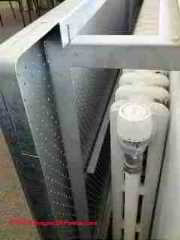 @Tom,
@Tom,
Three options:
1. Immediate, no-cost: just put a board atop the radiator, at least as wide and as long as needed to completely cover the radiator top and to project an inch or two past it - this alone will cut the radiator's heat output by about 20%. If your daughter doesn't have a board or even some books or magazines to put atop the radiator, she hang a towel or two over the radiator to reduce air movement around it, slowing heat transfer into the room
I attach a sketch showing two fancier radiator cover designs that will cut heat output.
2. Easy, low-cost, but some work: buy or build a radiator cover such as those we show above on this page:
RADIATOR BASEBOARD or CONVECTOR COVERS inspectapedia.com/heat/Radiator_Covers.php
3. Install a thermostatic radiator valve: Providing the radiator is piped as they usually are, repair or install the / a radiator control valve or better yet, install a thermostatically-controlled radiator valve that will automate the heat output as if there were a room thermostat, as we describe at
RADIATOR VALVES & HEAT CONTROLS
On 2021-12-04 by Tom
My daughter in Long Island has a 3 zone hot water heating system. I am in Florida and trying to help her remotely. 3 zones= Main area, great room and basement.
One of the bedrooms in the main area is much hotter than other main areas. It doesn’t look like there are any shut off valves at the radiator to reduce heat or totally turn it off.
How can she control the heat in that room without affecting other areas?
This Q&A were published originally at AIR BLEEDER VALVES
On 2017-09-02 by (mod) - But what materials are acceptable to build the cover?
Adam,
I'll be glad to help with this topic. You can also send me some representative photos - email is at the page bottom CONTACT link.
It should be possible to make radiator screen covers that prevent burns but that can be opened for access to radiators for service when needed.
We don't want to build something so permanent that you have to tear it apart to replace a steam vent or to open or close a radiator valve.
To make a radiator cover, I've used wood lattice, wood boards, sheet metal, and also I've made temporary covers for radiators out of expedient materials at hand - as long as the materials won't be damaged by heat and won't off-gas some obnoxious odor they might be used.
On 2017-09-02 by Adam Mygrants
Great info. But what materials are acceptable to build the cover?
My purpose is not cosmetic, I have many special needs kids that I am attempting to prevent burn injuries come winter, preferably without affecting the heat output. Steam standing iron radiator, going to attempt 8" grated bottom and grated top with insulated back. I've not yet tested It's unprotected surface heat.
Question/Comment: where to buy replacement covers for hot water (hydronic) heating baseboards
We manufacture Baseboarders - the most popular way to deal with problematic baseboard heater covers.
Quite often our product makes the difference between a fail or a pass when an inspection is conducted.
Address: Baseboarders Corp., 11765 Summit Crescent in Delta BC Canada V4E 2Z3
Telephone: 1 (800) 834-5672 - contact Jon Buss
Email: sales@baseboardheatercovers.com
Website: www.baseboarders.com
Reply:
We have added your company's contact information here for readers who need to buy replacement heating baseboard covers.
InspectAPedia is an independent publisher of building, environmental, and forensic inspection, diagnosis, and repair information provided free to the public - we have no business nor financial connection with any manufacturer or service provider discussed at our website. We are dedicated to making our information as accurate, complete, useful, and unbiased as possible:
we very much welcome critique, questions, or content suggestions for our web articles. Working together and exchanging information makes us better informed than any individual can be working alone.
Reader comment:
(Nov 2, 2011) Paul said:
Thanks for the Insulation tip! No where else I see that mentioned. I need to do 4 radiators and as it is the walls in the house don't have insulation. Thanks a million!
Paul
Reply:
Glad to assist, Paul. Should questions arise don't hesitate to ask.
Question:
(Nov 15, 2014) Jim Johnson said:
Where can I find 1960's vintage Slant Fin baseboard covers?
Reply:
Slant Fin sells compatible replacement covers.
Question: reader questions effects of radiator covers despite research cited
(Feb 23, 2015) J in Boston said:
I'm not sure that I agree with your interpretation of the effect of the covers on heat transfer efficiency. The % the change in effective radiation area - these data are used in sizing the heat output of a boiler that is connected to the radiator system. With greater convective air flow caused by some of the radiator cover designs, the radiators actually radiate more heat into the room. If one added a bunch of those radiator covers to the system, then the boiler size might need to be increased to keep up with the improve heat transmission into the room. This might be a useful solution for systems in which the boiler is actually oversized - a common problem - and short cycles because the radiators do not emit enough of the heat and the system becomes pressured prematurely as the vents close.
Reply:
J Boston
Thank you for the discussion.
The data we cited came from research by expert engineers at ITT (see References) including data from the manufacturers and from textbooks, not from the usual arm-waving that often is behind opinions in the trades. It is worth noting that the research was for steam radiators, but frankly, except for small differences in the temperatures between steam radiators and hot water radiators (and those are inconsistent from building to building and room to room within any building), the room air has no idea whether the radiator is filled with steam or with hot water.
But I certainly agree that radiation surface is not the whole story. Just consider a heating baseboard - a long flat small "radiator" in effect. If you take the covers off of the baseboard you'll stop the convective air movement from the floor up through the heater and thus it would seem clear that you'd impede its performance.
And I certainly agree too that in those ugly cases where heat output is excessive in a particular room or at a particular hydronic or steam radiator, occupants often build an enclosure to cool the heat output there. But it ought to be apparent that this is not the best solution; it'd be better to install a thermostatic radiator valve, for example.
...
Continue reading at RADIATOR or CONVECTOR INSULATION or select a topic from the closely-related articles below, or see the complete ARTICLE INDEX.
Or see these
Recommended Articles
- AIR BLEEDER VALVES
- AIR-BOUND HEATING SYSTEMS - home
- COLD HEATING RADIATOR REPAIR (hot water / hydronic heat)
- NO HEAT - BOILER or NO HEAT - FURNACE
- RADIATORS for ROOM HEAT - home
- RADIATOR STEAM VENTS - home
- RADIATOR VALVES & HEAT CONTROLS
- RADIATOR VOLUME & BTUs
Suggested citation for this web page
RADIATOR BASEBOARD or CONVECTOR COVERS at InspectApedia.com - online encyclopedia of building & environmental inspection, testing, diagnosis, repair, & problem prevention advice.
Or see this
INDEX to RELATED ARTICLES: ARTICLE INDEX to HEATING RADIATORS
Or use the SEARCH BOX found below to Ask a Question or Search InspectApedia
Ask a Question or Search InspectApedia
Try the search box just below, or if you prefer, post a question or comment in the Comments box below and we will respond promptly.
Search the InspectApedia website
Note: appearance of your Comment below may be delayed: if your comment contains an image, photograph, web link, or text that looks to the software as if it might be a web link, your posting will appear after it has been approved by a moderator. Apologies for the delay.
Only one image can be added per comment but you can post as many comments, and therefore images, as you like.
You will not receive a notification when a response to your question has been posted.
Please bookmark this page to make it easy for you to check back for our response.
Comments
IF above you see "Comment Form is loading comments..." then COMMENT BOX - countable.ca / bawkbox.com IS NOT WORKING.
In any case you are welcome to send an email directly to us at InspectApedia.com at editor@inspectApedia.com
We'll reply to you directly. Please help us help you by noting, in your email, the URL of the InspectApedia page where you wanted to comment.
Citations & References
In addition to any citations in the article above, a full list is available on request.
- Mark Cramer Inspection Services Mark Cramer, Tampa Florida, Mr. Cramer is a past president of ASHI, the American Society of Home Inspectors and is a Florida home inspector and home inspection educator. Mr. Cramer serves on the ASHI Home Inspection Standards. Contact Mark Cramer at: 727-595-4211 mark@BestTampaInspector.com
- John Cranor [Website: /www.house-whisperer.com ] is an ASHI member and a home inspector (The House Whisperer) is located in Glen Allen, VA 23060. He is also a contributor to InspectApedia.com in several technical areas such as plumbing and appliances (dryer vents). Contact Mr. Cranor at 804-873-8534 or by Email: johncranor@verizon.net
- [1] Dan Holihan, "Your Most Frequently Asked Questions About Cast-Iron Radiators – Answered! by Dan Holohan", http://www.oiltechtalk.com/pages/cast_iron.htm, retrieved 3/7/2013.
- Barnes & Jones Corporation, 91 Pacella Park Drive Randolph, MA 02368, Tel: 781-963-8000calibrated steam traps and vents, Email: bnesbitt@barnesandjones.com. Vent-Rite steam vents for radiator control.
- Energy Savers: Heat Distribution Systems, Steam Radiators & Hot Water Radiators, U.S. Department of Energy, web search 12/27/2010, original source: http://www.energysavers.gov/your_home
/space_heating_cooling/index.cfm/mytopic=12580 - Gorton Heating Corporation, 546 South Avenue East, Cranford, New Jersey 07016, Tel: 908-276-1323, email: info@gorton-valves.com, fast venting valves for steam heating systems.
- "Rv-4 One-Pipe Steam Radiator Valve", available from Armstrong International,
816 Maple Street, Three Rivers, MI 49093 USA, Tel: (269) 273-1415, Armstrong has offices in Beijing, China, Belgium, India and Mexico. Web search 12/27/2010, original source:
http://www.armstronginternational.com/thermostatic-valves-rv-4-one-pipe. - [6] "Special Steam Vents", Hoffman Specialty heating products, web search 12/27/2010, original source:
http://www.hoffmanspecialty.com/pdf/hs900/HS900-3474.pdf - [7] "Steam and Water Vents, Selection Guidelines - Steam Vents", Hoffman Specialty, web search 12/27/2010, original source:
http://www.hoffmanspecialty.com/pdf/hs900/HS900-stvents.pdf - Hoffman 1A adjustable steam vents, available from Hoffman Specialty, ITT, web search 12/27/2010, original source:
http://www.drillspot.com/products/51570/Hoffman_1A_Adjustable_Automatic_Air_Vent_For_Steam_Radiators - Hoffman Convector Steam Vents, available from Hoffman Specialty, ITT, web search 12/28/2010, original source:
http://www.hoffmanspecialty.com/pdf/hs900/HS900-conv109.pdf - [10] Report 95-14, PB96-198163 Thermostatic Radiator Valve (TRV) Demonstration Project, contact NYSERDA. 17 Columbia Circle, Albany, NY 12203-6399 Toll-Free: 1-866-NYSERDA, Tel:(518)465-6252, Ext. 241. Web Search 12/27/2010, original source: http://www.homeenergy.org/archive/hem.dis.anl.gov/eehem/96/960509.html
- [11] VariValve® Quick-Vent from Heat Timer, adjustable radiator and main line vent valves for one pipe steam systems, web search 12/27/2010, original source: http://www.heat-timer.com/enFiles/ProductDocument/literature/VariV056082C.pdf
- [12] "Care & Feeding of Air Vents", Dan Holohan, Old House Journal Online, November 2004
- Barry Price, AIA, LEED, AP, is an architect in the Hudson Valley, in Bearsville New York, 845-679-3282 bprice@barryprice.com
- DeLonghi Mica Panel Radiators can be wall-mounted and function similar to older designs of electric wall mounted heating convectors. We do not recommend modifying or replacing the manufacturer's covers on products such as this one and we do not recommend constructing home made covers to install over portable heaters of any type. Doing so risks a fire. Examples of fire and heat safety clearances for the DeLonghi electric panel heater are shown in this DeLonghi heater installation manual. - http://www.delonghiusa.com/index.php?product&nid=27
- DeLonghi electric fan convector unit installation manual
- Thanks to reader Alan Pickles for ongoing discussion of the use of MDF radiator covers or pre-fab radiator covers with convection heaters 02/11/2010
- Utica Boilers - The company's Utica Boiler Literature Page link: http://www.uticaboilers.com/product_literature.asp provides download links to current product information for the company's absolutely huge list of products.
Utica provides a useful document - Utica Radiation Tables - that allows a homeowner or heating service technician to determine the heat output of a traditional cast iron radiator, measured in square feet of radiation. - Original document source: http://www.ecrinternational.com/secure/upload/document/293.pdf - Our recommended books about building & mechanical systems design, inspection, problem diagnosis, and repair, and about indoor environment and IAQ testing, diagnosis, and cleanup are at the InspectAPedia Bookstore. Also see our Book Reviews - InspectAPedia.
- In addition to citations & references found in this article, see the research citations given at the end of the related articles found at our suggested
CONTINUE READING or RECOMMENDED ARTICLES.
- Carson, Dunlop & Associates Ltd., 120 Carlton Street Suite 407, Toronto ON M5A 4K2. Tel: (416) 964-9415 1-800-268-7070 Email: info@carsondunlop.com. Alan Carson is a past president of ASHI, the American Society of Home Inspectors.
Thanks to Alan Carson and Bob Dunlop, for permission for InspectAPedia to use text excerpts from The HOME REFERENCE BOOK - the Encyclopedia of Homes and to use illustrations from The ILLUSTRATED HOME .
Carson Dunlop Associates provides extensive home inspection education and report writing material. In gratitude we provide links to tsome Carson Dunlop Associates products and services.


